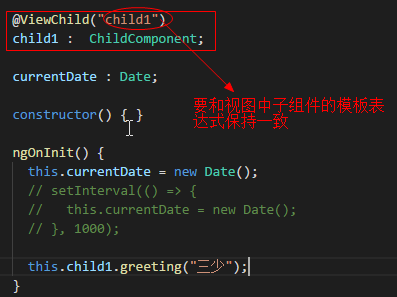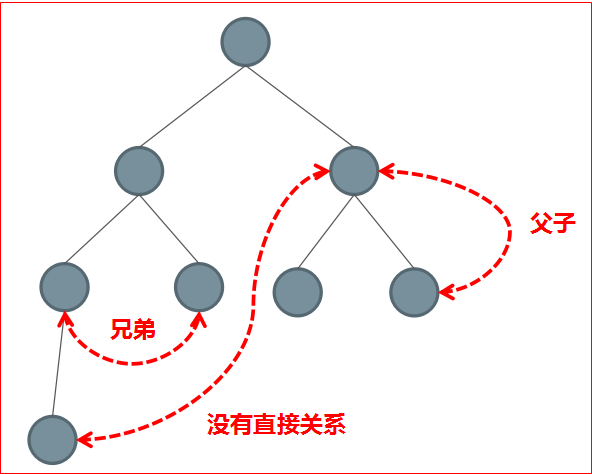1 父组件和子组件之间的通讯
2 利用中间组件实现两个组件之间的通讯
3 利用服务实现两个组件之间的通讯
2017年8月26日20:09:13
待更新...
1 组件之间的关系图
1.1 父子关系
1.2 兄弟关系
1.3 没啥关系
2 组件之间有以下几种典型的通讯方案
2.1 直接父子关系
2.1.1 父组件直接访问子组件的 public 属性和方法
技巧01:父组件的视图中调用子组件的方法需要利用模板变量
技巧02:父组件的类中调用子组件的方法需利用@ViewChild装饰器
2.1.2 借助于 @Input 和 @Output 进行通讯
就是利用输入属性和输出属性来实现
技巧01:输入属性和输出属性需要用到属性绑定和事件绑定相关的知识
2.2 兄弟关系
利用他们共同的父组件进行通信【有点麻烦】
技巧01:此时他们的父组件相当于一个中间人
2.3 适用于任何关系的方法
2.3.1 借助于service单例进行通讯
2.3.2 利用cookie或者localstorage进行通讯
2.3.3 利用session进行通讯
3 直接调用
对于父子组件而言,父组件可以直接调用子组件的public型属性和方法
缺点:如果父组件直接访问子组件,那么两个组件之间的关系就被固定死了。父子两个组件紧密依赖,谁也离不开谁,也就都不能单独使用了。所以,除非你知道自己在做什么,最好不要直接在父组件里面直接访问子组件上的属性和方法,以免未来一改一大片。
3.1 利用模板变量实现

3.2 利用@ViewChild实现

3.3 代码汇总
》父组件

<div class="panel panel-primary"> <div class="panel-heading">父组件</div> <div class="panel-body"> <child #child1 ></child> <p> <label>获取子组件的info属性值为:</label> <span>{{child1.info}}</span> </p> <p> <button (click)="child1.greeting('王杨帅');">调用子组件的greeting方法</button> </p> </div> <div class="panel-footer">{{currentDate | date : "yyyy-MM-dd HH:mm:ss"}}</div> </div>

import { Component, OnInit, ViewChild } from '@angular/core';
import { ChildComponent } from './child/child.component';
import { AfterViewInit, AfterContentChecked, AfterContentInit, AfterViewChecked } from '@angular/core/src/metadata/lifecycle_hooks';
@Component({
selector: 'parent',
templateUrl: './parent.component.html',
styleUrls: ['./parent.component.scss']
})
export class ParentComponent implements OnInit {
@ViewChild("child1")
child1 : ChildComponent;
currentDate : Date;
constructor() { }
ngOnInit() {
this.currentDate = new Date();
// setInterval(() => {
// this.currentDate = new Date();
// }, 1000);
this.child1.greeting("三少");
}
}
》子组件

<div class="panel panel-primary"> <div class="panel-heading">子组件</div> <div class="panel-body"> </div> <div class="panel-footer">{{currentDate | date : "yyyy-MM-dd HH:mm:ss"}}</div> </div>

import { Component, OnInit, DoCheck,AfterViewChecked, EventEmitter, AfterContentInit, Output, Input, OnChanges, SimpleChanges, AfterViewInit, AfterContentChecked } from '@angular/core';
@Component({
selector: 'child',
templateUrl: './child.component.html',
styleUrls: ['./child.component.scss']
})
export class ChildComponent implements OnInit {
currentDate : Date;
info : string;
constructor() { }
ngOnInit() {
this.info = "子组件中的info属性";
this.currentDate = new Date();
// setInterval(() => {
// this.currentDate = new Date();
// }, 1000);
}
greeting(name : string) : void {
alert("子组件中greeting方法的返回值: Helo " + name);
console.log("子组件中greeting方法的返回值: Helo " + name);
}
}
4 @Input 和 @Output
就是通过属性绑定来实现父组件向子组件的输入属性船值;通过事件绑定来实现子组件向父组件传值
技巧01:其实可以直接利用双向绑定来实现
4.1 父组件向子组件传值
子组件利用@Input定义一个输入属性,父组件视图中在子组件的标签上利用属性绑定来实现
4.2 子组件向父组件传值
子组件利用@Output定义一个输出属性,父组件视图中在子组件标签上利用事件来实现
4.3 代码汇总
》父组件

<div class="panel panel-primary"> <div class="panel-heading">父组件</div> <div class="panel-body"> <!-- 这三种写法都可以实现 --> <!-- <child [info]="parentInfo" (infoChange)="onInfoChange($event)" ></child> --> <!-- <child [info]="parentInfo" (infoChange)="parentInfo=$event" ></child> --> <child [(info)]="parentInfo" ></child> <p> {{parentInfo}} </p> </div> <div class="panel-footer">{{currentDate | date : "yyyy-MM-dd HH:mm:ss"}}</div> </div>

import { Component, OnInit, ViewChild } from '@angular/core';
import { ChildComponent } from './child/child.component';
import { AfterViewInit, AfterContentChecked, AfterContentInit, AfterViewChecked } from '@angular/core/src/metadata/lifecycle_hooks';
@Component({
selector: 'parent',
templateUrl: './parent.component.html',
styleUrls: ['./parent.component.scss']
})
export class ParentComponent implements OnInit {
parentInfo : string;
currentDate : Date;
constructor() { }
ngOnInit() {
this.parentInfo = "王杨帅";
this.currentDate = new Date();
// setInterval(() => {
// this.currentDate = new Date();
// }, 1000);
}
onInfoChange(info : string) {
this.parentInfo = info;
}
}
》子组件

<div class="panel panel-primary"> <div class="panel-heading">子组件</div> <div class="panel-body"> <p> 输入属性info的值为:{{info}} </p> <p> <button (click)="onTest()" >点击向父组件发送数据</button> </p> </div> <div class="panel-footer">{{currentDate | date : "yyyy-MM-dd HH:mm:ss"}}</div> </div>

import { Component, OnInit, DoCheck,AfterViewChecked, EventEmitter, AfterContentInit, Output, Input, OnChanges, SimpleChanges, AfterViewInit, AfterContentChecked } from '@angular/core'; @Component({ selector: 'child', templateUrl: './child.component.html', styleUrls: ['./child.component.scss'] }) export class ChildComponent implements OnInit { currentDate : Date; @Input() info : string; @Output() infoChange : EventEmitter<string> = new EventEmitter(); constructor() { } ngOnInit() { this.currentDate = new Date(); // setInterval(() => { // this.currentDate = new Date(); // }, 1000); } onTest() : void { this.infoChange.emit("子组件传过来的数据"); } }
5 服务实现
待更新...
6 cookie或localstorage实现
6.1 原理图

6.2 代码汇总
》工具组件
利用投影来简化代码

<div class="panel panel-primary"> <div class="panel-heading"> <ng-content select=".heading"></ng-content> </div> <div class="panel-body"> <ng-content select=".body"></ng-content> </div> <div class="panel-footer"> {{currentDate | date : "yyyy-MM-dd HH:mm:ss"}} </div> </div>

import { Component, OnInit } from '@angular/core';
import { setInterval } from 'timers';
@Component({
selector: 'panel',
templateUrl: './panel.component.html',
styleUrls: ['./panel.component.scss']
})
export class PanelComponent implements OnInit {
currentDate : Date;
constructor() { }
ngOnInit() {
this.currentDate = new Date();
setInterval(() => {
this.currentDate = new Date();
}, 1000);
}
}
》测试组件01

<panel> <div class="heading"> 测试组件01 </div> <div class="body"> <button (click)="onClick()">写入数据到</button> </div> </panel>

import { Component, OnInit } from '@angular/core';
import { TestService } from '../services/test.service';
@Component({
selector: 'test01',
templateUrl: './test01.component.html',
styleUrls: ['./test01.component.scss']
})
export class Test01Component implements OnInit {
constructor(
) { }
ngOnInit() {
}
onClick() : void {
// 将对象转化成JSON字符串并存储道浏览器缓存中
window.localStorage.setItem("user", JSON.stringify({name: "王杨帅", age: 9}));
}
}
》测试组件02

<panel> <div class="heading"> 测试组件02 </div> <div class="body"> <p> <button (click)="onClick()">获取数据</button> </p> </div> </panel>

import { Component, OnInit } from '@angular/core';
import { TestService } from '../services/test.service';
@Component({
selector: 'test02',
templateUrl: './test02.component.html',
styleUrls: ['./test02.component.scss']
})
export class Test02Component implements OnInit {
constructor(
) { }
ngOnInit() {
}
onClick() : void {
// 从浏览器缓存中获取数据【PS: 获取到的是string类型的数据】
let data = localStorage.getItem("user");
console.log(data);
// 将JSON字符串转化成对象
let json_data = JSON.parse(data);
console.log(json_data.name);
window.localStorage.removeItem("user");
}
}
7 session实现
待更新...

